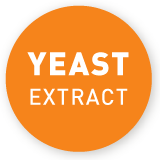Yeast is used in the production of various tasty foods and drinks. Even though the flavour of unprocessed yeast may taste unpleasant, its contribution as a basic ingredient in processing is essential in many cases.
Bread is one of the most widely consumed staple foods in which yeast is used. The soft dough, the typical aroma and the crispy crust of a fresh loaf of bread are something we often take for granted – and yet a multitude of biochemical processes occur in its production that many people are not aware of. Yeast plays a key role in this process, as it is what ensures the fluffy dough. What’s more, it also influences the subsequent taste of the bread. As a living micro-organism, it performs important preliminary work for the baking process and the creation of the distinctive aromas that we all love in fresh bread: The yeast converts the sugar formed from the starch in the flour into carbon dioxide and the existing proteins into flavourings. These flavourings have a positive effect on the process of the so-called Maillard reaction which occurs later during the baking. The Maillard reaction takes place at a temperature of 150 – 180 degrees Celsius and occurs everywhere where sugar and protein molecules are exposed to high temperatures – in baking just as much as in frying meat or roasting coffee. Through several intermediate stages, compounds are created here with a pleasant aroma and typical dark colours. In baking, the reaction takes place in the outer layers of the bread especially intensely, which is why the crust usually has the strongest taste.
In the production of yeast extract no Maillard reaction takes place; its spicy taste of its own is based on the natural ingredients of the yeast cell. First sugar is added to the yeast, which is left to grow at around 30 degrees Celsius. Next, the so-called autolysis takes place at a temperature of 45 – 55 degrees Celsius: This is when enzymes break down the proteins contained in the yeast cell into smaller components. At the same time they dissolve the surrounding cell wall so that the flavouring components can escape from the cell. The amino acids that are dissolved out of the yeast proteins are what we taste in the spicy, bouillon-like taste of yeast extract. This includes the natural amino acid glutamate, which is present in yeast extract just as it is in all other protein-rich foods.
So, thanks to their qualities as living micro-organisms and their rich protein compounds, yeasts are true all-rounders and contribute in various ways to enriching our diet – whether by optimally preparing the flavouring chemical reactions in baking or by providing the basis for yeast extract, which rounds off our meals as a flavoursome ingredient.



